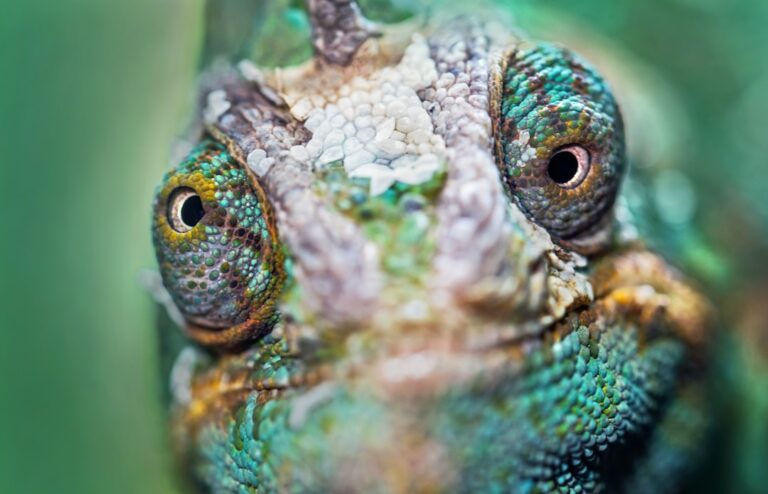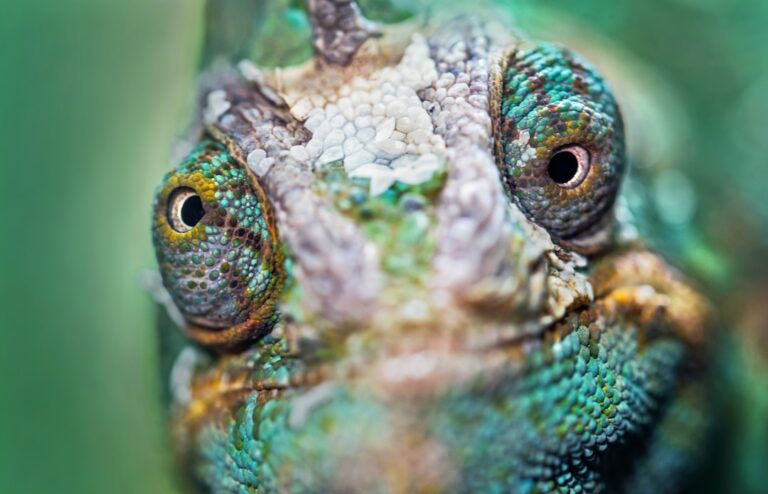Why Do Chameleons Get Black Spots?
Chameleons are fascinating creatures known for their unique ability to change color. These reptiles have the remarkable ability to alter the pigmentation of their skin, allowing them to blend in with their surroundings or communicate with other chameleons. This color-changing ability is not only visually stunning, but it also serves important functions in the chameleon’s survival and well-being.
Table of Contents
Understanding the Role of Melanin in Chameleon Skin
Melanin is a pigment that is responsible for the coloration of the skin, hair, and eyes in many animals, including humans. In chameleons, melanin plays a crucial role in their ability to change color. Melanin is produced by special cells called melanocytes, which are located in the skin. When these cells produce more melanin, the chameleon’s skin becomes darker, and when they produce less melanin, the skin becomes lighter.
The production of melanin in chameleon skin is influenced by various factors, including genetics, hormones, and environmental conditions. The amount and type of melanin produced can vary between different species of chameleons, resulting in a wide range of colors and patterns.
Environmental Factors that Influence Chameleon Coloration
Environmental factors such as temperature and humidity can have a significant impact on chameleon coloration. Chameleons are ectothermic animals, which means that their body temperature is regulated by their environment. When a chameleon is exposed to cooler temperatures, its body temperature drops, causing a decrease in melanin production and resulting in lighter skin coloration. Conversely, when a chameleon is exposed to warmer temperatures, its body temperature increases, leading to an increase in melanin production and darker skin coloration.
Humidity levels also play a role in chameleon coloration. Chameleons that live in humid environments tend to have brighter and more vibrant colors compared to those in drier environments. This is because the moisture in the air helps to enhance the visibility of the pigments in their skin.
Chameleons are highly adaptable creatures and can change their coloration to match their surroundings. This ability allows them to camouflage themselves from predators or blend in with their environment while hunting for prey. For example, a chameleon living in a green leafy environment may change its skin color to green, making it nearly invisible to predators.
The Importance of UVB Light for Chameleon Health and Color
UVB light plays a crucial role in chameleon health and coloration. Chameleons require exposure to UVB light in order to synthesize vitamin D3, which is essential for calcium metabolism and overall bone health. Without adequate UVB light, chameleons can develop metabolic bone disease, which can lead to skeletal deformities and other health issues.
In addition to its role in vitamin D3 synthesis, UVB light also affects chameleon coloration. UVB light stimulates the production of melanin in the skin, resulting in darker pigmentation. Chameleons that are not exposed to sufficient UVB light may have duller or lighter skin coloration.
It is important for chameleon owners to provide proper UVB lighting in their pet’s enclosure. This can be achieved by using specialized reptile UVB bulbs that emit the appropriate wavelengths of light. It is also important to ensure that the UVB bulb is replaced regularly, as the output of UVB decreases over time.
How Stress and Aggression Can Affect Chameleon Coloration
Chameleons are highly sensitive creatures and can change their coloration in response to stress or aggression. When a chameleon feels threatened or stressed, it may darken its skin color as a warning signal to potential predators or rivals. This darkening of the skin is often accompanied by other defensive behaviors, such as puffing up the body or hissing.
Similarly, chameleons may also change their coloration during aggressive encounters with other chameleons. This color change serves as a visual signal to establish dominance or to communicate aggression. The intensity and pattern of the color change can vary depending on the individual chameleon and the specific situation.
It is important for chameleon owners to provide a stress-free environment for their pets. This includes providing adequate hiding spots, minimizing handling, and avoiding sudden loud noises or disturbances. A stressed or agitated chameleon may exhibit abnormal coloration or behavior, which can be a sign of underlying health issues.
The Influence of Hormones on Chameleon Skin Pigmentation
Hormones play a significant role in chameleon skin pigmentation. Hormonal changes can affect the production and distribution of melanin in the skin, resulting in changes in coloration. For example, during mating season, male chameleons may develop brighter and more vibrant colors to attract females. This is often accompanied by other courtship behaviors, such as head bobbing or displaying their throat pouch.
Female chameleons may also experience hormonal changes during pregnancy or egg-laying. These hormonal changes can affect their skin coloration, making them appear darker or lighter depending on the specific species.
It is important for chameleon owners to be aware of these hormonal changes and provide appropriate care during these periods. This may include adjusting the temperature and humidity levels in the enclosure or providing additional nutritional support.
Genetic Factors that Contribute to Chameleon Coloration
Genetics play a significant role in chameleon coloration. Different species of chameleons have unique genetic traits that determine their color patterns and pigmentation. Some species have vibrant and contrasting colors, while others have more muted or camouflaged coloration.
Within a species, individual chameleons may also exhibit variations in coloration due to genetic factors. This can result in a range of colors and patterns within a single population.
Selective breeding has also played a role in the development of different color morphs in captive chameleons. Breeders have selectively bred chameleons with specific color traits to produce offspring with desired coloration. This has resulted in a wide variety of color morphs available in the pet trade.
The Evolutionary Significance of Chameleon Color Changing Abilities
The ability to change color has evolved in chameleons as a survival mechanism. Chameleons use their color-changing abilities for various purposes, including camouflage, communication, and thermoregulation.
Camouflage is one of the primary functions of chameleon coloration. By changing their skin color to match their surroundings, chameleons can effectively hide from predators or ambush prey. This allows them to blend into their environment and remain undetected.
Chameleons also use their color-changing abilities for communication. They can display different colors and patterns to convey messages to other chameleons. For example, a male chameleon may change its skin color to signal aggression or dominance during territorial disputes.
Color changes can also help chameleons regulate their body temperature. By altering their skin color, they can absorb or reflect sunlight, which helps them maintain optimal body temperature.
Common Misconceptions about Chameleon Black Spots
One common misconception about chameleons is that black spots on their skin indicate poor health or stress. In reality, black spots are a natural part of a chameleon’s coloration and can vary between individuals and species.
Black spots on a chameleon’s skin are often caused by the presence of melanin. These spots can appear as random patterns or as distinct markings on the body. They are not necessarily an indication of any underlying health issues.
It is important for chameleon owners to understand that black spots are a normal part of a chameleon’s coloration and should not be a cause for concern unless accompanied by other abnormal symptoms.
How to Properly Care for a Chameleon’s Skin Health and Coloration
Proper care is essential for maintaining a chameleon’s skin health and coloration. This includes providing a suitable habitat, a balanced diet, and proper hydration.
Chameleons require a spacious enclosure with plenty of climbing branches and foliage. The enclosure should also have proper temperature and humidity levels to ensure the chameleon’s well-being. UVB lighting is also crucial for their health and coloration, as discussed earlier.
A balanced diet is important for maintaining a chameleon’s skin health and coloration. Chameleons are insectivores and require a variety of live insects, such as crickets, mealworms, and roaches. It is important to provide gut-loaded insects that have been fed a nutritious diet to ensure that the chameleon receives adequate nutrients.
Hydration is also crucial for chameleon skin health. Chameleons obtain most of their water from the moisture on leaves or by drinking droplets of water. It is important to mist the enclosure regularly to provide humidity and to offer a shallow dish of water for the chameleon to drink from.
Chameleons are truly remarkable creatures with their ability to change color. Their unique color-changing abilities are influenced by various factors, including melanin production, environmental conditions, hormones, genetics, and UVB light exposure. Understanding these factors is crucial for providing proper care for a chameleon’s skin health and coloration.
By providing a suitable habitat, proper nutrition, hydration, and UVB lighting, chameleon owners can help maintain their pet’s vibrant colors and overall well-being. It is important to remember that each chameleon is unique, and their coloration may vary depending on various factors. With proper care and attention, chameleons can thrive and display their stunning colors for years to come.
If you’re interested in learning more about reptiles, you might also enjoy reading the article “Do Iguanas Blink?” on Reptile Friend’s website. This informative piece explores the fascinating behavior of iguanas and delves into the reasons behind their blinking habits. To find out why these reptiles blink and what it means for their overall well-being, click here.







